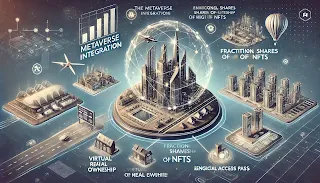The Rise of NFTs: Market Growth and Future Potential in 2024
Introduction
Explore the rise of non-fungible tokens (NFTs) and their impact on art, gaming, music, and virtual real estate. Learn about the rapid market growth, future potential, and challenges facing the NFT ecosystem. Non-fungible tokens (NFTs) have revolutionized the digital asset space, transforming how art, music, gaming, and virtual real estate are bought and sold. Unlike cryptocurrencies such as Bitcoin or Ethereum, which are fungible and can be exchanged on a one-to-one basis, NFTs are unique digital assets that represent ownership of a specific item or piece of content. This article explores the rise of NFTs, their market growth, and their future potential.
The Rise of NFTs
NFTs first gained mainstream attention in 2017 with the launch of CryptoKitties, a blockchain-based game where players could buy, breed, and trade virtual cats. However, it wasn't until 2020 and 2021 that NFTs truly exploded into the public consciousness, driven by high-profile sales and increasing interest from artists, celebrities, and investors.
- Art and Collectibles: NFTs have opened up new revenue streams for artists by allowing them to sell digital art directly to consumers, often with smart contracts that ensure artists receive royalties on secondary sales.
- Gaming: In-game items and assets can now be tokenized, allowing players to own, trade, and sell items independently of the game developer.
- Music and Entertainment: Musicians and entertainers are using NFTs to sell exclusive content, concert tickets, and fan experiences, creating new ways to monetize their work.
Market Growth
The NFT market has seen exponential growth, with sales volumes reaching unprecedented levels. According to DappRadar, NFT sales hit $25 billion in 2021, up from $95 million in 2020. This growth has been fueled by several factors:
- Increased Adoption: More platforms and marketplaces, such as OpenSea, Rarible, and Foundation, are making it easier for creators and collectors to buy and sell NFTs.
- Celebrity Endorsements: High-profile endorsements and collaborations have brought significant attention to the NFT space, driving mainstream interest and investment.
- Institutional Interest: Financial institutions and venture capital firms are investing in NFT platforms and technologies, further legitimizing the market.
Future Potential
The future of NFTs is bright, with numerous opportunities for further growth and innovation. Key areas to watch include:
- Metaverse Integration: NFTs are expected to play a crucial role in the development of the metaverse, a collective virtual shared space that is emerging from the convergence of virtually enhanced physical reality and physically persistent virtual reality. Digital assets and virtual real estate in the metaverse will likely be bought and sold as NFTs.
- Fractional Ownership: Fractional ownership allows multiple investors to own a piece of a high-value NFT, making it more accessible and increasing liquidity in the market.
- Enhanced Utility: NFTs are evolving beyond simple ownership of digital art or assets. They can now represent access to exclusive content, membership in communities, or rights to real-world assets.
- Environmental Concerns: Addressing the environmental impact of NFTs, particularly those on energy-intensive blockchains like Ethereum, will be crucial. The adoption of more energy-efficient blockchain technologies and the transition to Ethereum 2.0 could mitigate these concerns.
Challenges and Considerations
Despite their potential, NFTs face several challenges:
- Regulatory Uncertainty: The regulatory landscape for NFTs is still evolving. Clear guidelines and regulations will be necessary to protect consumers and ensure the market's long-term viability.
- Market Volatility: The NFT market is highly speculative and can be volatile, with prices for digital assets fluctuating widely.
- Intellectual Property Issues: Ensuring that NFTs do not infringe on intellectual property rights and verifying the authenticity of digital assets are ongoing challenges.
Conclusion
NFTs have rapidly emerged as a transformative force in the digital asset space, offering new opportunities for creators, collectors, and investors. With continued innovation and adoption, the NFT market is poised for further growth, particularly as it integrates with emerging technologies like the metaverse. However, addressing challenges such as regulatory uncertainty and environmental impact will be crucial for sustaining this growth and realizing the full potential of NFTs.



%20to%20Proof%20of%20Stake%20(PoS).%20The%20image%20should%20depict%20a%20clean%20and%20modern%20design.webp)

Comments
Post a Comment